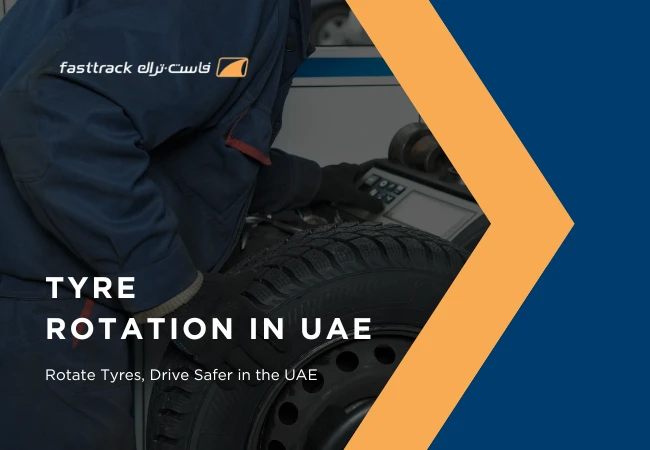 Date: August 29, 2025
Date: August 29, 2025
Tyre Rotation: The Importance of Regular Rotation in the UAE
Tyre Rotation is nothing complicated, but it makes a real difference. It’s the practice of moving tyres from one position to another, front to back, sometimes even diagonally, depending on the vehicle. The point is to let every tyre share the workload instead of leaving the front pair to wear out faster. When the wear is even, the tread holds up longer, braking stays balanced, and handling remains predictable on UAE roads where heat already puts extra stress on rubber. Skipping it shortens tyre life and, in many cases, voids the warranty that comes with them.
Why is Tyre Rotation important in the UAE?
Tyres in the UAE don’t wear out the same way they do elsewhere. The heat, the long stretches of highway, and the constant stop–go traffic in city areas put unusual strain on them. Rotation matters because it spreads that load. Instead of the front tyres burning out quickly under braking and steering, switching their position with the rear helps each one last longer.
When wear is balanced, the car handles better. Braking feels more controlled, cornering doesn’t feel uneven, and the steering stays predictable even at higher speeds on roads like Sheikh Zayed or Emirates Road. There’s also the matter of efficiency tyres that roll smoothly without rough patches on the tread, reducing drag, which means less fuel wasted.
Safety is another factor that drivers in the region can’t overlook. Irregular wear makes tyres lose grip suddenly, especially when rain hits polished asphalt. For those driving AWD vehicles, rotation does more than protect tyres; it lowers strain on the drivetrain, preventing early mechanical wear. Manufacturers also tie warranty coverage to proper rotation. Miss it, and replacement costs fall back on the owner. For UAE conditions, tyre rotation isn’t a small maintenance step. It’s what keeps the vehicle reliable, safe, and economical.
When to Rotate Tyres for Your Cars?
General Guidelines
On UAE roads, tyres wear faster than many drivers expect, which is why rotation needs to be on a fixed schedule. A safe interval is every 6,000 miles, about 10,000 km. Some car makers give a range between 5,000 and 8,000 miles (9,600–12,800 km), but the message is simple—don’t leave the same set of tyres on the same corner for too long. The easiest way to remember is to do it when the car goes in for an oil change, or at least twice a year. Drivers changing from winter to summer tyres can rotate at the same time, keeping all four in equal use. For vehicles on heavier duty, like commercial vans and pickups, the very first rotation should be around 6,000 km to set the tread wear evenly right from the start.
When to Rotate More Often
Certain conditions in the UAE call for rotation sooner than the standard interval. Long drives at high speeds, heavy loads, or daily highway runs wear tyres unevenly. If a driver notices tread wearing faster on one axle, or hears a low humming sound that often points to heel-and-toe wear, rotation shouldn’t wait. The same applies when one or two tyres are replaced—rotation helps the new set blend in with the old ones so all four stay balanced. Leaving it unchecked leads to shorter tyre life and less predictable handling.
What Manufacturers Advise
Every car model is built differently, so the owner’s manual remains the most accurate guide for rotation intervals and patterns. Following these instructions not only protects the tyres but also keeps warranty conditions intact. One guideline, however, applies to all vehicles: new tyres should always be mounted on the rear axle. Even in front-wheel-drive cars, stronger tread at the back maintains stability and prevents the vehicle from sliding out during hard braking or on rain-slick roads. This small step makes a noticeable difference in safety.
How to Rotate Tyres?
Professional Service Recommended
Rotation is usually better handled at a garage. A mechanic doesn’t just change the tyres around; he looks at tread depth, checks for cracks from heat, and makes sure the alignment isn’t pulling the wheels off balance. Nuts are tightened with the right torque, something most people at home can’t measure. In the UAE, we also see tyres hardening or developing sidewall damage from long hours in the sun. Workshops are trained to spot this before it becomes a safety risk.
DIY Rotation
It can be done at home, but only with care. The car’s manual gives the correct pattern front to back, cross, or side swaps depending on the tyre type. Wheel nuts need to be tightened exactly to spec, not just “as tight as it feels.” Each wheel must be seated properly before lowering the car; otherwise, vibration shows up at highway speeds. And safety matters most: if only one jack is used without stands, the car isn’t stable. That’s where accidents happen.
Conditions for Rotation
- Rotation is possible only if all tyres are the same size. Different-sized front and rear tyres limit options.
- Directional tyres restrict the process further—they can only be moved front to back on the same side.
- Vehicles with a full-size spare can include it in the rotation, which shares wear across all five tyres instead of leaving one unused.
Tread Patterns
Directional
These tyres have arrows printed on the sidewall. The arrow shows the direction they must roll. Because of that, they can only move front to back on the same side of the car.
Asymmetric
You’ll see “Outside” marked on one side of these tyres. That side always faces outward. They can be swapped from front to rear but not flipped around, so the orientation never changes.
Symmetrical
The most flexible design. With the same tread running across the whole tyre, they can be rotated in almost any pattern-front to back, side to side, or diagonally.
Tyre Rotation Patterns
Uniform Size & Non-Directional Tyres
Cars with tyres of equal size at all four corners give the most rotation options.
- Forward Cross: The front tyres move straight to the rear. The rear tyres swap over to the opposite front corners.
- Rearward Cross: The rears move forward in a straight line. The fronts cross to the rear corners.
- X-Pattern: Each tyre goes diagonally from front right to rear left, front left to rear right.
Directional Tyres
These have arrows on the sidewall showing which way they should roll. They can’t be swapped side to side. The only option is front to back on the same side.
Staggered or Differently-Sized Tyres
Performance cars often have wider tyres at the back. In that case, rotation is limited to side-to-side swaps on each axle.
5-Tyre Rotation
If the car carries a full-size spare, all five should be included. Each tyre takes a turn on every corner, which keeps wear even across the set. For AWD and 4WD vehicles, this is particularly important, since uneven tread depths can stress the drivetrain.
Dual and Studded Tyres
Trucks with dual rear wheels have specific patterns, inner to outer, or side to side, so the load is shared. Studded tyres, where they’re used, are simply rotated front to back, never across, to keep the studs aligned with their cutting direction.
What Tyre Rotation won’t Fix?
Tyre rotation is useful, but it isn’t a cure-all. It won’t correct problems caused by wrong inflation pressures; underinflated or overinflated tyres will still wear unevenly. It also can’t undo irregular tread wear that comes from poor wheel alignment; that requires an alignment check and adjustment. If tyres already have heel-and-toe wear, which often creates a humming sound while driving, rotation won’t remove the noise. And balance issues are separate altogether. If the steering wheel shakes or the car vibrates at certain speeds, the tyres need balancing, not just rotation. Rotation only spreads wear; it doesn’t solve underlying faults.
On UAE roads, tyres wear out faster than many drivers expect. Heat, speed, and long-distance driving put uneven pressure on them, and without rotation, one pair will always wear down before the others. Rotating tyres at the right time evens out the load, keeps handling steady, and helps the set last longer. At Fasttrack Emarat, rotation is carried out as part of a full tyre service. Along with it, drivers can get punctures repaired, tyres replaced or newly fitted, wheels balanced and aligned, tyres mounted and inspected, wheel protectors installed, pressure checked, and nitrogen refilling done in one stop.
